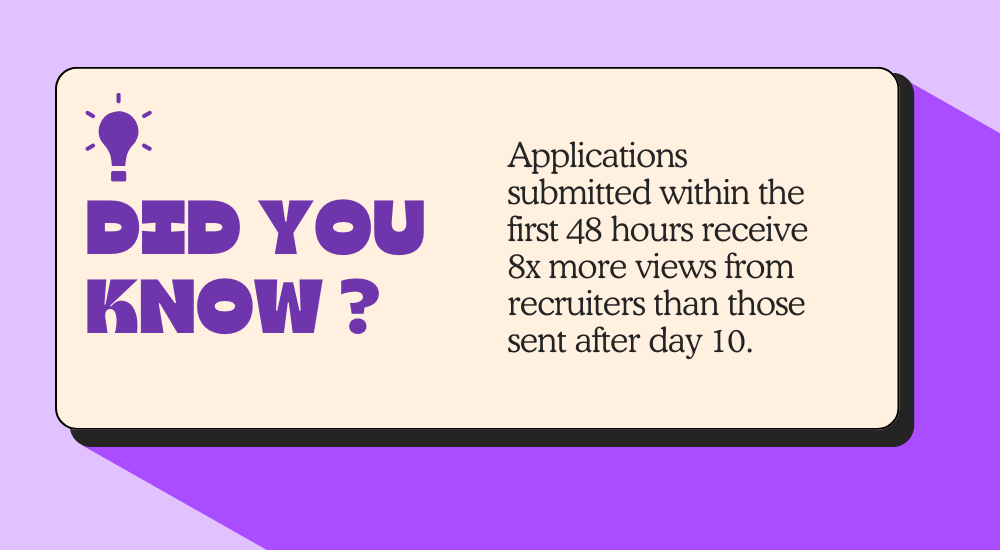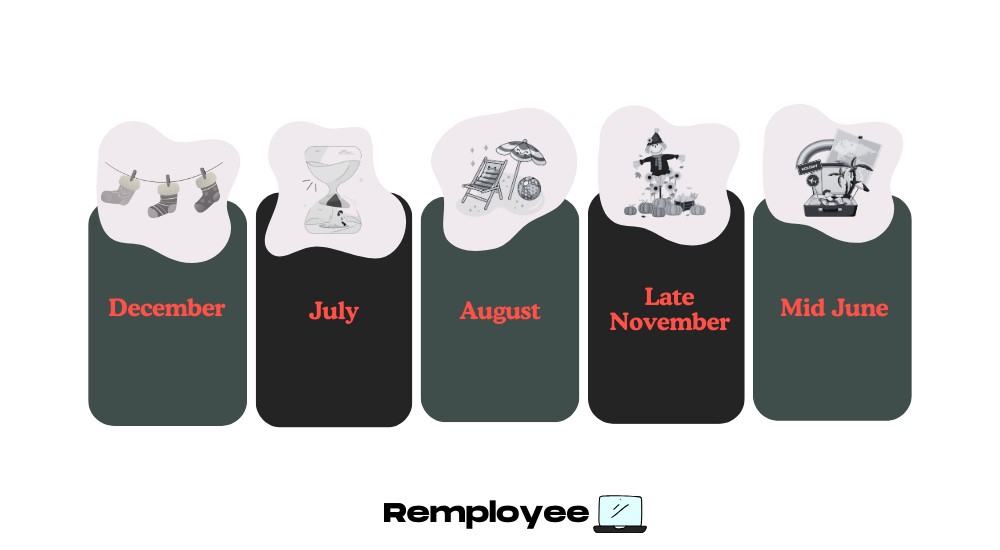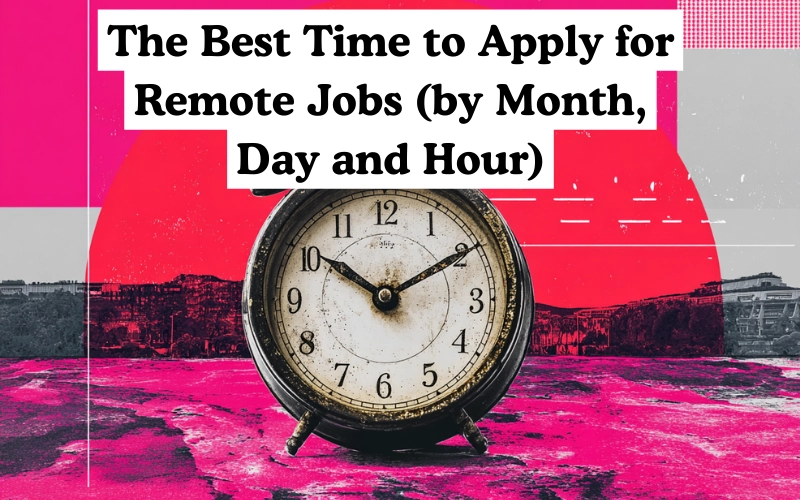Every Tuesday at 10 AM, hiring managers open their inboxes fresh from Monday’s chaos.
Your remote job application sits there, waiting.
Most candidates blast applications at random times, wondering why they hear nothing back. They apply Sunday night. Friday afternoon. Whenever they remember.
But timing changes everything.
The data shows clear patterns in remote hiring cycles, response rates, and interview invitations.
Understanding when to submit your application could be the difference between landing that dream remote role and getting lost in the digital pile.
Does Time to Apply for a Remote Job Matter?

Yes, timing dramatically impacts your application’s success rate. According to LinkedIn’s 2024 Global Talent Trends report, applications submitted within the first 48 hours receive 8x more views from recruiters than those sent after day 10. Remote positions amplify this effect because companies receive applications from every time zone simultaneously.
The competition intensifies quickly. A single remote role attracts 3x more applicants than location-based positions. Your perfectly crafted resume gets buried under hundreds of others when you apply late. Recruiters often stop reviewing applications once they find enough qualified candidates. They move fast in remote hiring to secure top talent before competitors do.
Early applications also signal genuine interest and preparedness. Hiring managers notice who responds quickly to new postings. This enthusiasm matters, especially for remote roles where self-motivation drives success.
Peak Hiring Months for Remote Positions
January through March and September through November dominate remote hiring activity. Companies launch new budgets, projects, and team expansions during these periods. The data reveals consistent patterns across industries:
January brings fresh budgets and new headcount approvals. Teams scramble to fill roles before Q1 ends. September mirrors this pattern as companies push for year-end goals. October maintains momentum before the holiday slowdown begins.
Remote-first companies often hire more aggressively during these peaks than traditional organizations. They know talent pools expand when professionals seek change after summer breaks or year-end reflections.
Worst Months to Submit Remote Applications

December, July, and August create application black holes for remote job seekers. During these months, your carefully crafted application often vanishes into silence.
- December: Holiday schedules mean decision-makers disappear for weeks. Budgets freeze. Hiring committees postpone meetings until January.
- July: Vacation season hits hard. Key stakeholders travel. Teams operate with skeleton crews who focus on maintaining operations, not reviewing resumes.
- August: The vacation spillover continues. European companies essentially shut down. Even US teams struggle to coordinate interviews with scattered staff.
- Late November: Thanksgiving week kills momentum. Everything stalls until after New Year celebrations.
- Mid-June: Quarter-end pressures override hiring priorities. Finance teams lock budgets for review.
Apply during these periods only for urgent roles or when you spot “immediate start” language. Otherwise, bookmark the position and return when activity resumes.
Best Days of the Week to Apply
Tuesday and Wednesday applications consistently outperform all other days for remote positions. Monday applications compete with weekend accumulation. Thursday and Friday submissions risk getting lost in weekend planning chaos.
Hiring managers tackle strategic tasks early in the week. They review applications when energy peaks, not when they rush toward weekend deadlines. Tuesday mornings find them refreshed from Monday’s planning sessions, ready to evaluate candidates. Wednesday maintains this momentum before late-week meetings consume their schedules.
Optimal Hours for Submitting Applications
Submit between 10 AM and 11 AM in the company’s primary time zone for maximum visibility. Morning applications land atop inbox queues when hiring managers start their focused work blocks. Tools like Boomerang for Gmail or Microsoft’s Schedule Send feature let you time delivery perfectly, even when applying outside standard hours.
Avoid the 8 AM rush when emails flood in overnight. Skip lunch hours when attention splits. Never send after 6 PM unless the posting explicitly mentions flexible hours or async work culture. Late-night applications suggest poor boundaries – a red flag for remote positions requiring self-management.
The 10 AM sweet spot works because managers have cleared urgent morning tasks. They review applications before meetings dominate their afternoons. Your resume gets undivided attention during their peak productivity window.
Seasonal Hiring Patterns in Remote Work
Remote hiring follows predictable seasonal rhythms that mirror business cycles and human behavior. Understanding these patterns transforms random applications into strategic moves.
- Spring surge (March-May): Companies execute plans conceived during January strategy sessions. Startups launch with fresh funding. Teams expand for summer projects.
- Summer slowdown (June-August): Hiring crawls. Vacations dominate calendars. Only critical roles get filled.
- Fall frenzy (September-November): The year’s biggest hiring push. Companies race to spend remaining budgets. Teams prep for next year’s initiatives.
- Winter mix (December-February): December dies, January explodes. New budgets unlock positions frozen since October.
- Q1 momentum: Fresh goals drive aggressive hiring. Everyone wants to start strong.
Remote companies amplify these patterns. They hire harder during peak seasons, knowing global talent becomes available. They also pause more completely during slow periods, preserving resources for competitive times.
Industry-Specific Remote Hiring Timelines
Different industries run completely different remote hiring calendars. Tech companies hire year-round while education follows academic schedules. Retail peaks before holidays. Finance explodes after bonus season.
Tech maintains the most consistent hiring. E-commerce prepares for Black Friday by September. Finance waits for post-bonus departures. Education aligns with semester schedules. Marketing agencies staff up after winning new accounts in January.
Holiday Periods: Apply or Wait?
Wait for January unless the role explicitly states “urgent” or “immediate start.” A Glassdoor study found that applications submitted between December 15 and January 5 receive 73% fewer responses than those sent January 8-15. The math speaks clearly.
Companies operate with skeleton crews during holidays. Decision-makers vacation. Budgets freeze. Your application sits unread while automated systems pile new submissions on top. Even when someone reviews December applications in January, they appear stale. Recruiters assume you found another role or lost interest.
The exception? Startups posting during holidays often need someone immediately. They sacrifice holiday hiring challenges for urgent needs. These roles typically mention “ASAP” or “immediate availability required” in descriptions. Apply fast when you spot these signals. Otherwise, save your effort for January’s hiring explosion.
Time Zone Strategies for Global Remote Jobs
Master time zones to maximize your remote application success. US companies dominate remote hiring, but European and Asian opportunities grow rapidly. Each region requires different timing strategies.
Submit US applications between 10-11 AM EST to reach both coasts during peak hours. European roles need 10-11 AM CET timing for maximum visibility. Asian positions vary widely—research the specific country’s business culture first.
World Time Buddy eliminates time zone confusion completely. This free tool shows multiple time zones simultaneously, preventing embarrassing midnight applications. Set up your target company’s zone alongside your own. Schedule applications when their morning aligns with your evening if needed.
Global companies often list positions in multiple time zones. Apply using the headquarters’ time zone unless the job posting specifies otherwise. Remote-first companies sometimes review applications asynchronously, making timing less critical. Check their careers page for hints about their hiring process.
Wrap Up
Timing transforms your remote job search from random shots into calculated moves.
You now know January and September create golden opportunities. Tuesday mornings at 10 AM get maximum attention. December applications vanish into the void.
Stop applying whenever you feel like it. Start treating each application as a strategic decision.
Set calendar reminders for peak hiring months. Schedule your applications for optimal days and hours. Research industry-specific patterns for your target roles.
The remote job market moves fast. Companies hire quickly. Your dream role appears and disappears within days.
Armed with this timing knowledge, you compete differently. You apply when hiring managers actually read resumes. You avoid dead zones that waste your effort.
Your next remote role waits. Time your move right.
After years of freelancing through broken systems and vague job boards, Josie built Remployee to help others find what she couldn’t at first: flexible work that feels like freedom, not chaos. She believes real jobs should fit real lives—and that thoughtful writing can be a bridge to better work. If you’re looking for permission to choose differently, Josie’s already given it.



